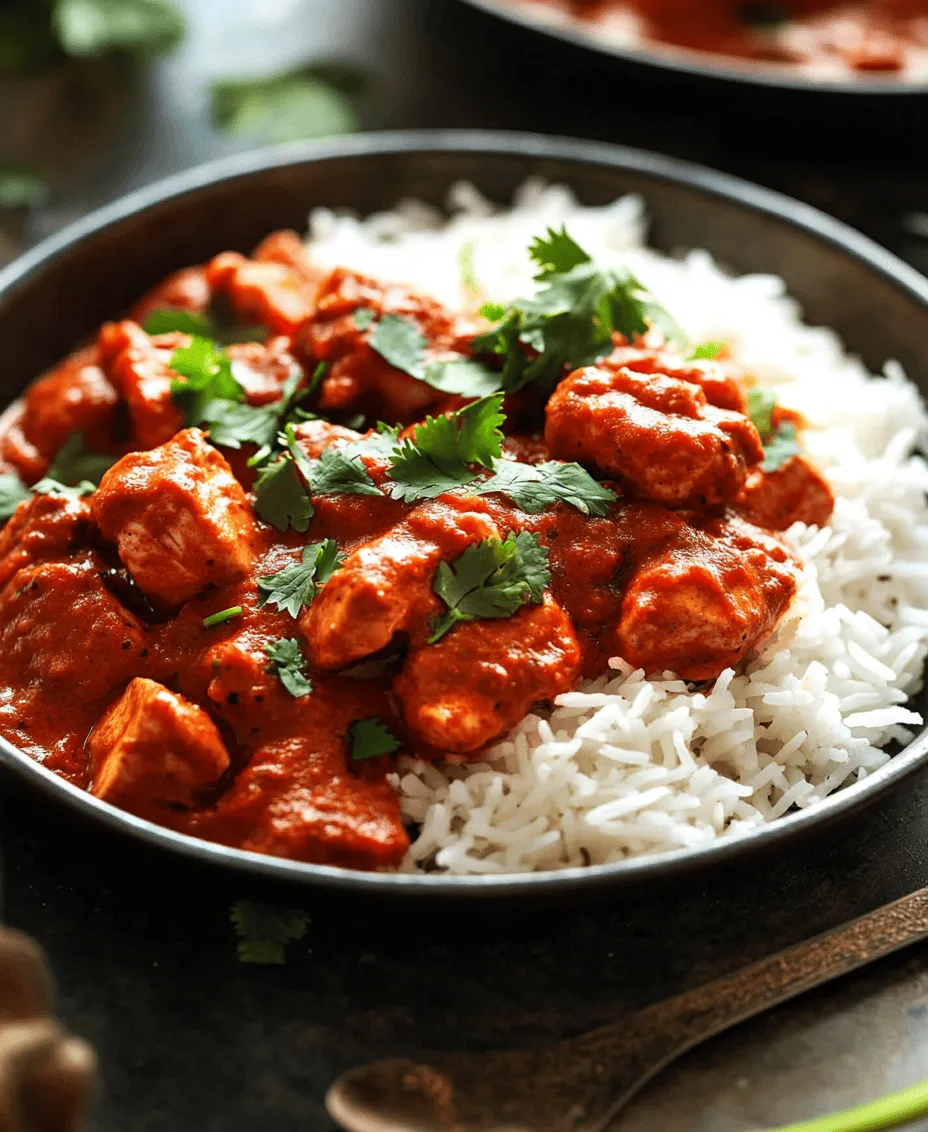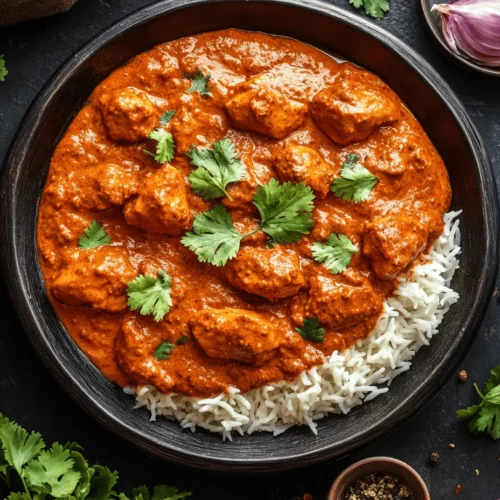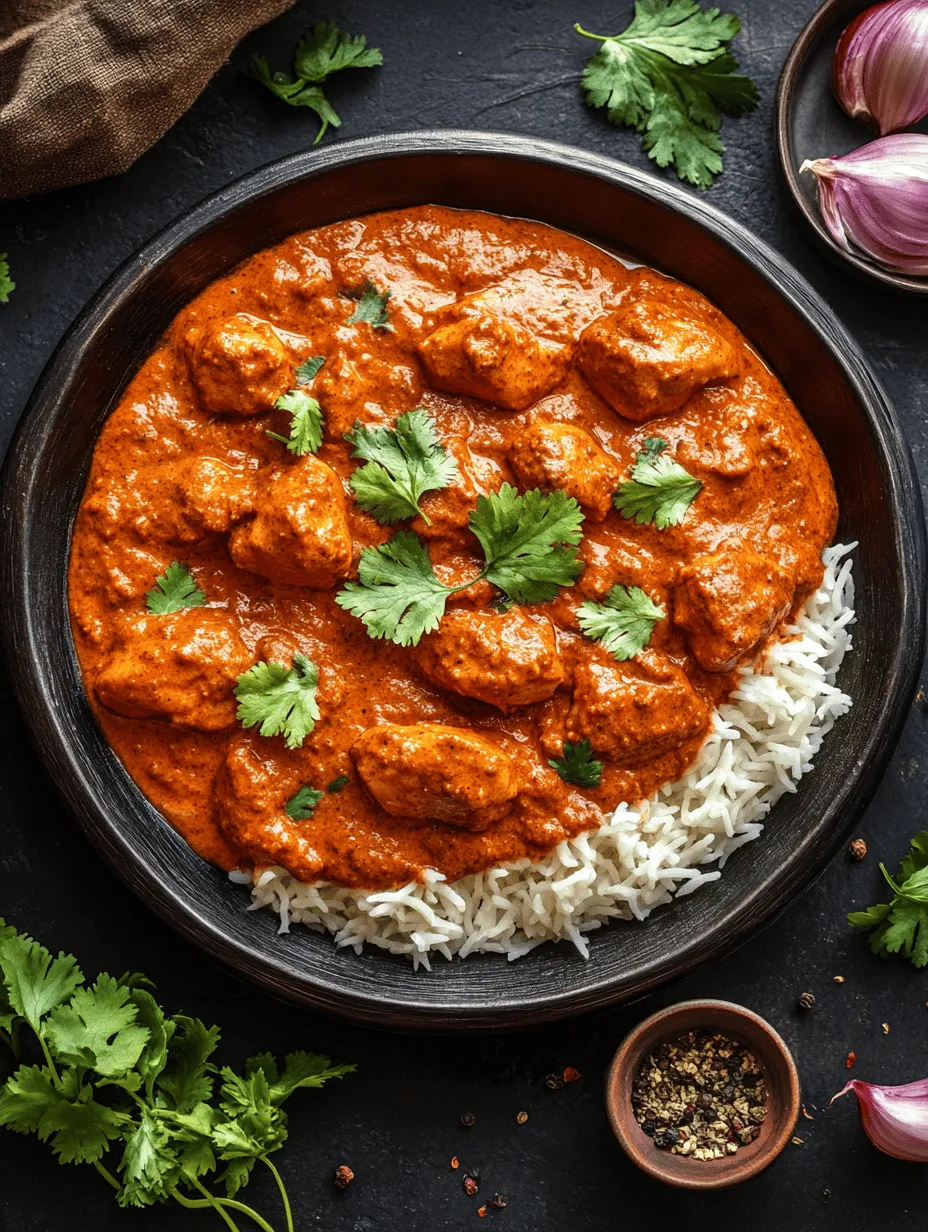Introduction
Chicken Tikka Masala is not just a dish; it’s a culinary phenomenon that has captivated taste buds around the world. This beloved dish, rooted in Indian cuisine, has found its way into the hearts (and stomachs) of food lovers globally. Its rich, creamy sauce combined with tender pieces of marinated chicken creates a symphony of flavors that is hard to resist. With its origins often debated between India and the UK, Chicken Tikka Masala has transcended cultural boundaries to become a staple in many households and restaurants alike.
When it comes to preparing this classic dish, few names are as revered as Gordon Ramsay. Known for his high standards and impeccable culinary skills, Ramsay’s approach to Chicken Tikka Masala emphasizes authenticity and flavor while maintaining the dish’s traditional roots. By incorporating fresh ingredients and aromatic spices, he elevates this comforting meal to new heights, making it accessible for home cooks who aspire to bring restaurant-quality dishes to their dining tables.
Cooking at home not only fosters creativity but also allows for greater control over ingredients and flavors. By preparing Chicken Tikka Masala from scratch, you can ensure that every bite is bursting with freshness and health benefits. This recipe will guide you through each step, making it easy to replicate Ramsay’s flavorful classic in your own kitchen.
Understanding the Key Ingredients
To successfully create Gordon Ramsay’s Chicken Tikka Masala, it’s essential to understand the key ingredients that contribute to its distinct flavor profile. Here’s a breakdown of what you’ll need:
Essential Ingredients for Chicken Tikka Masala
1. Chicken: The star of the dish, boneless chicken thighs or breasts are typically used for their tender texture and ability to soak up flavors.
2. Yogurt: This ingredient plays a crucial role in marinating the chicken. It not only infuses the meat with flavor but also helps tenderize it, resulting in juicy, succulent pieces of chicken.
3. Spices: Spices are the heart of Indian cuisine. For Chicken Tikka Masala, you’ll need:
– Cumin: Adds a warm, earthy flavor.
– Coriander: Contributes a citrusy undertone.
– Garam Masala: A blend of spices that enhances the overall complexity of the dish.
– Turmeric: Provides a vibrant color and a subtle bitterness.
– Cayenne Pepper: Adds a kick of heat, which can be adjusted according to your spice tolerance.
4. Heavy Cream: This ingredient is essential for creating the rich, velvety sauce that envelops the chicken. It balances the spices and adds a luxurious texture.
5. Tomatoes: Fresh or canned tomatoes are used as the base for the sauce, providing acidity and sweetness that complement the spices.
The Role of Yogurt in Marinating Chicken
Marinating chicken in yogurt is a traditional technique that not only infuses flavor but also ensures tenderness. The lactic acid in yogurt breaks down the proteins in the chicken, making it more tender and juicy. Additionally, it helps the spices adhere to the meat, enhancing the overall flavor profile. A well-marinated chicken will absorb the spices deeply, creating a harmonious blend of tastes in every bite.
The Significance of Spices
The spices used in Chicken Tikka Masala are what truly set this dish apart. Each spice brings its unique characteristics and health benefits:
– Cumin is known for its digestive properties and ability to enhance the immune system.
– Coriander is rich in antioxidants and has anti-inflammatory effects.
– Garam Masala is a powerhouse blend that varies by region but typically includes spices like cardamom, cloves, and cinnamon, all known for their health benefits.
– Turmeric is renowned for its anti-inflammatory properties and vibrant color.
– Cayenne Pepper not only adds heat but is also believed to boost metabolism and improve circulation.
Understanding how these ingredients work together is key to creating a Chicken Tikka Masala that is not only flavorful but also nutritious.
The Marinade Process
The Importance of Marination
Marination is a critical step in preparing Chicken Tikka Masala. It allows the chicken to absorb the flavors of the yogurt and spices, resulting in a dish that is bursting with taste. A good marinade can transform ordinary chicken into a flavor-packed centerpiece, ensuring that every bite is enjoyable.
Creating the Perfect Marinade
To create the perfect marinade for Gordon Ramsay’s Chicken Tikka Masala, follow these steps:
1. Combine the Ingredients: In a large mixing bowl, combine plain yogurt, lemon juice, minced garlic, grated ginger, and your selected spices (cumin, coriander, garam masala, turmeric, and cayenne pepper). The yogurt serves as the base while the spices add depth.
2. Add the Chicken: Cut the chicken into bite-sized pieces and add them to the marinade. Ensure that each piece is well-coated. This step is vital for flavor penetration.
3. Marinate: Cover the bowl with plastic wrap and refrigerate for at least 1 hour, though marinating for longer (up to 24 hours) will yield even better results. The longer the chicken sits in the marinade, the more tender and flavorful it becomes.
Tips for Optimal Flavor Infusion
– Use Fresh Ingredients: Fresh spices and aromatics will enhance the overall flavor of the marinade. If possible, use whole spices and grind them yourself for maximum potency.
– Adjust to Taste: Feel free to tweak the spices to suit your palate. If you prefer a milder dish, reduce the cayenne pepper; if you like it spicier, increase it.
– Time Matters: While marinating for an hour is beneficial, allowing the chicken to marinate overnight is ideal. This will allow the flavors to fully develop and permeate the meat.
Cooking the Chicken
Once the chicken has marinated to perfection, it’s time to move on to the cooking process. There are several methods to cook the marinated chicken, each with its unique advantages.
Baking vs. Grilling
1. Baking: Preheat your oven to 400°F (200°C). Line a baking sheet with parchment paper and arrange the marinated chicken pieces in a single layer. Bake for 15-20 minutes, or until the chicken is cooked through and slightly charred. Baking is a convenient method that allows for even cooking and easy cleanup.
2. Grilling: For a more authentic flavor, grilling the chicken can impart a delightful smoky taste. Preheat your grill to medium-high heat. Thread the marinated chicken onto skewers (if using wooden skewers, soak them in water for 30 minutes beforehand) and grill for about 10-15 minutes, turning occasionally, until the chicken is cooked through and has beautiful grill marks. Grilling not only enhances the flavor but also adds a lovely charred texture that complements the creamy sauce.
Achieving the Perfect Charred Texture
Regardless of the cooking method you choose, achieving a charred texture is essential for flavor development. The caramelization that occurs during cooking creates a depth of flavor that balances the creaminess of the sauce.
Cooking Times and Temperature Settings
– For baking, aim for an internal temperature of 165°F (75°C) for the chicken. This ensures that the meat is fully cooked while remaining juicy.
– When grilling, the same internal temperature applies. Use a meat thermometer to check for doneness, ensuring that your chicken is perfectly cooked and safe to eat.
In the next section, we will explore crafting the Tikka Masala sauce that brings this dish together, transforming the grilled or baked chicken into a vibrant, flavorful meal. Stay tuned for the delightful culmination of flavors that result from this culinary journey.

Step-by-Step Breakdown of the Sauce Preparation Process
To create a Chicken Tikka Masala that rivals any restaurant dish, the sauce is a critical component. Start by heating a generous amount of oil or ghee in a large pan over medium heat. This foundational step sets the stage for a richly flavored sauce.
1. Sautéing Onions, Garlic, and Ginger: Begin by adding finely chopped onions to the hot oil. Sauté them until they become soft and translucent, which typically takes about 5-7 minutes. This slow cooking is crucial, as it allows the natural sugars in the onions to caramelize, enhancing the overall flavor profile. Once the onions are golden, add minced garlic and ginger. Sauté for an additional 2-3 minutes until fragrant. The combination of these three aromatics forms the backbone of your sauce, creating a warm and inviting base.
2. Incorporating Spices and Tomatoes: Now, it’s time to layer in the spices that define Chicken Tikka Masala. Add ground cumin, coriander, garam masala, turmeric, and a pinch of chili powder for heat. Stir these spices into the onion mixture, allowing them to bloom in the oil for about 1 minute. This process releases the essential oils from the spices, intensifying their flavors. Next, pour in crushed tomatoes or tomato puree, scraping any bits stuck to the pan. The acidity from the tomatoes balances the spices and provides a rich, tangy flavor. Allow the mixture to simmer for about 10-15 minutes so that the tomatoes reduce and the flavors meld beautifully.
3. Balancing Flavors: Taste the sauce periodically as it cooks. The balance of flavors can often be adjusted by adding a pinch of sugar to counteract the acidity of the tomatoes or an extra pinch of salt to enhance the overall taste. This step is essential to achieve that signature depth and complexity that makes Chicken Tikka Masala so beloved.
Combining Chicken and Sauce
Once your sauce is perfectly blended and aromatic, it’s time to bring in the star of the dish—the marinated chicken.
1. Incorporating the Baked Chicken: Take the marinated chicken pieces out of the oven. They should be beautifully charred and aromatic. Gently add them to the simmering sauce, ensuring that the chicken is well coated. The heat from the sauce will continue to cook the chicken, allowing it to absorb all the flavors.
2. Simmering Process: Let the chicken and sauce simmer together for about 10-15 minutes on low heat. This simmering process is vital as it melds the flavors together, ensuring that every bite of chicken is infused with the rich, spicy sauce. Stir occasionally, checking the consistency of the sauce; if it’s too thick, you can add a splash of water or chicken stock to reach your desired consistency.
3. Visual and Sensory Cues: You’ll know your Chicken Tikka Masala is ready when the sauce has thickened to a creamy consistency, and the chicken is tender. The vibrant color of the sauce should be a deep orange-red, and the aromatic blend of spices will fill your kitchen. The flavors should be rich and well-rounded, with a hint of heat and a comforting warmth.
Serving Suggestions
Chicken Tikka Masala is best enjoyed with traditional accompaniments that complement its flavors beautifully.
1. Basmati Rice and Naan: Serve your dish over a bed of fluffy basmati rice, which acts as a perfect base to soak up the creamy sauce. Alternatively, warm naan bread is ideal for scooping up the chicken and sauce, adding a delightful texture to each bite. Both options are staple sides that elevate the dining experience.
2. Garnishing with Fresh Cilantro: To enhance both the presentation and flavor of your Chicken Tikka Masala, garnish with freshly chopped cilantro. The bright green herb adds a pop of color and a fresh, herbaceous note that cuts through the richness of the dish.
3. Cultural Significance: In Indian cuisine, Chicken Tikka Masala is not just a dish; it’s a cultural icon. Often enjoyed during family gatherings and celebrations, it embodies the essence of Indian hospitality—offering comfort and warmth through food. It’s a dish that brings people together, making it perfect for sharing with loved ones.
Nutritional Benefits of Chicken Tikka Masala
While Chicken Tikka Masala is a decadent dish, it also offers nutritional benefits worth noting.
1. Nutritional Profile Overview: A single serving of Chicken Tikka Masala typically provides a good balance of protein, carbohydrates, and fats, making it a hearty meal. The chicken is an excellent source of lean protein, which aids in muscle repair and growth, while the sauce provides healthy fats from cooking oils and the addition of cream or yogurt.
2. Health Benefits of Spices: The spices used in Chicken Tikka Masala are not just for flavor; they also contribute health benefits. For instance, turmeric contains curcumin, known for its anti-inflammatory properties, while ginger can aid digestion and reduce nausea. The use of garlic adds immune-boosting properties, making this dish not only delicious but also beneficial for your health.
3. Balance of Macronutrients: This dish effectively combines protein from chicken, healthy fats from cream or yogurt, and carbohydrates from the basmati rice or naan. This balance makes it a fulfilling meal that can provide lasting energy throughout the day.
Conclusion
Gordon Ramsay’s Chicken Tikka Masala is a celebration of flavors that encapsulates the essence of Indian cuisine. The meticulous preparation of the sauce, the careful marination of the chicken, and the thoughtful balancing of spices come together to create a dish that is both comforting and vibrant.
By trying your hand at this Chicken Tikka Masala recipe, you’ll not only hone your cooking skills but also gain an appreciation for the cultural significance and the joy of sharing homemade meals with family and friends. The process of cooking is a rewarding experience that allows you to express creativity and love through food. So, roll up your sleeves, gather your ingredients, and embark on this culinary journey to bring the rich, aromatic flavors of Chicken Tikka Masala into your kitchen.


